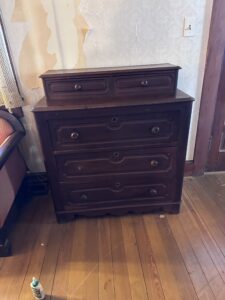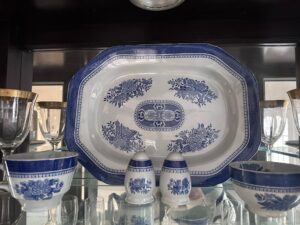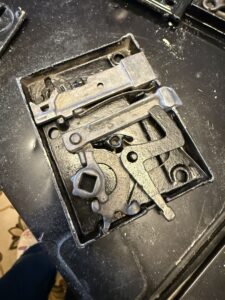Beginning in the 1760s, the Chinese invented a superior “Imperial Quality Export Porcelain” to out-do English potteries. This competition resulted in a group of very rare, high-quality thin porcelain pieces that were manufactured until about 1820. One design applied to this high-quality porcelain was the so-called Trophies series, which was made up of four similar patterns. The Fitzhugh pattern is among these. (https://gotheborg.com/qa/exportforthewest.shtml)
In the 1770s Thomas Fitzhugh was a director of the East India Company who exported these beautiful china patterns. As the story goes, either he or William Fitzhugh, a ship captain, ordered a china pattern. Today’s Fitzhugh Spode pattern features elements of that original Chinese export pattern.
About Trophies and the Fitzhugh pattern
The Trophies patterns and Dagger (the Trophies pattern named after the Fitzhughs) resemble designs found on Chinese textiles of the late 1700s, These fabrics might have served as an inspiration to the designer of the Trophies patterns. The Trophies patterns consist of four groups of flowers or plants spaced evenly around a central panel, which is sometimes replaced with a coat-of-arm, initials, or a scenic view. In each of the four groups are items that represent four Treasures or Trophies.
There are four Trophies china patterns, each with different borders. These are Trophies Nankin, Trophies Etruscan, Trophies Marble, and Trophies Dagger, also known as Trophies Fitzhugh. Each of these patterns diaper border, or repeating geometric border, with a coordinating design in the center. Sometimes the center designs are medallion-like, and sometimes they have a blank space that is filled with armorial devices or monograms. (See https://www.microwavecookingforone.com/Spode/SpodeTrophies.php)
Though most of the Fitzhugh pattern china has a diaper pattern with alternating daggers and dumbbells along its border, some of the Fitzhugh style of pottery included a butterfly motif. The butterfly border is sometimes called a Fitzhugh Border:

What is the significance of the Fitzhugh pattern to Poplar Grove Farm?
The Fitzhughs of Poplar Grove Farm are the distant cousins of the Fitzhughs after whom the Fitzhugh China pattern is named. The first Fitzhugh at Poplar Grove Farm was Lee Brockenbrough Fitzhugh, who married Sallie Virginia French Fitzhugh. Sallie was the grand-daughter of Sarah Curtis French, who was the first member of our family to live at the Farm. The Fitzhugh name was associated with Poplar Grove Farm for almost 100 years, from 1916 until 2022, when Lee’s daughter, Sally Lou Fitzhugh, passed away. The current owners and occupants of Poplar Grove Farm are direct-line Fitzhugh descendants, but their descendancy is through the maternal line, and they do not have the last name Fitzhugh.
If the China was orginal to China, how did Spode get involved?
Spode is an English pottery brand known for its quality pieces, headquartered is in Stoke-on-Trent in Staffordshire, England, about 125 miles from the Fitzhugh family’s ancestral homeland in Bedfordshire, England. Staffordshire is known for its pottery, and the county of Stafford, Virginia, where Poplar Grove farm is located, has sometimes partnered with Stafford, UK, for Anglican church exchanges. I attended one of these exchanges in 1997 and toured the Spode pottery factory.
Spode recreated legacy pottery patterns including Fitzhugh over many years. because Fitzhugh was a name associated with Chinese porcelain patterns that had become popular in the United States near the end of the eighteenth century. Fitzhugh Spode is now discontinued.
What do the symbols on Fitzhugh china mean?
Fitzhugh pattern has an inner border, or nankin, with a honeycomb or butterfly motif. According to The Transferware Database of Collectors and Sources, “The central medallion in this pattern contains flowers of the 4 seasons: Peony for spring, Lotus for summer, Chrysanthemum for autumn, and Prunus for winter. The Four Treasures, or Accomplishments are music, chess, calligraphy, and painting.” These motifs and groups of four trophies are the same in all Trophies family china, although the style of each pattern is different. The central motif on the Fitzhugh china pattern is said to represent the Chinese symbol of Good Fortune, however, a reverse image search turns up no similar Chinese patterns, and it just seems to be four lions to me. I’d bet the lion symbolizes the English ancestry of the Fitzhughs.
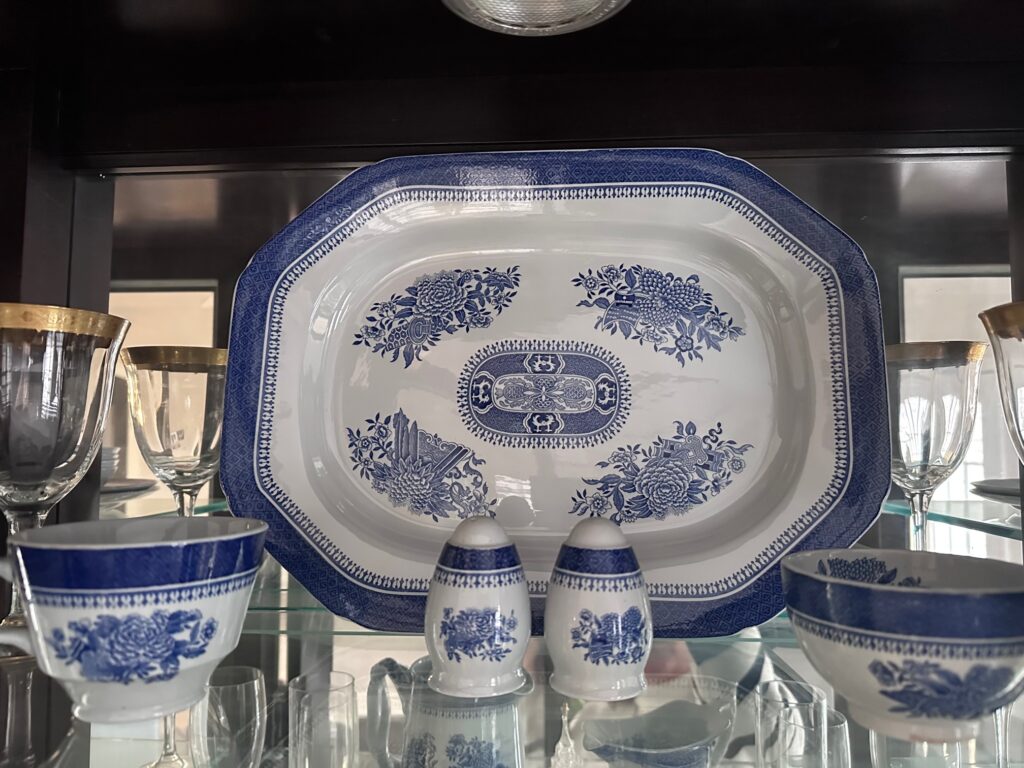
According to historian Henry Fitzhugh, author of History of the Fitzhugh Family in Two Volumes, “The Fitzhugh china pattern originates from three representatives of two generations of Fitzhughs of the English branch who became sea captains and even a Director of the British East India Company. Senior officers of the EIC were allowed to trade on their own account, and during the period 1704-1790s they shipped much of the pattern to England. For more information see an article by J.B.S. Holmes in the American magazine “Antiques”, January 1966, pp.130-1; also Spode’s Willow Pattern and other Designs after the Chinese, Ch. 14, The Chinese Trophies and Fitzhugh Patterns, Robert Copeland, 1990.”
There’s more information on Thomas and William Fitzhugh, the East India Company representatives to China, in an article by Kenneth Cozens of the Greenwich Maritime Institute, University of Greenwich titled
East London merchant networks in Asia: the Fitzhughs, 1750 -1800, East India Company agents in Macao (https://www.academia.edu/10873795/East_London_merchant_networks_in_Asia_The_Fitzhugh_s_1750_1800).
[Fitzhugh Spode is an e]arly formalized four paneled decoration on Chinese export porcelain. The name Fitzhugh for this pattern derives from an association with a blue and white service ordered around 1780 by Englishman Thomas Fitzhugh. Thomas Fitzhugh served from 1786 to 1800 in Guangzhou (Canton) as a director of the British East India Company. The most detailed decorations seems to be dating to the last decades of the 18th century. It occurs in several different colors, among which underglaze blue and white is the most common. Of the enameled varieties, green seems to have been the most popular.
This decoration can also be found with different center decorations copied from export prints, such as a pagoda, or various armorial crests.
Fitzhugh porcelain survives in a large range of dinner-, beverage- and ornamental-ware shapes and was particularly popular in North America. Underglaze blue and white Fitzhugh designs are most commonly met with. Yellow, black, or mulberry enameled Chinese Fitzhugh wares, as well as those bearing blue enamel and gilt ornament, are particularly rare.
Senior officers of the EIC were allowed to trade on their own account, and during the period 1704-1790s they shipped much of the pattern to England.
For more information see an article by J.B.S. Holmes in the American magazine “Antiques”, January 1966, pp.130-1; also Spodes Willow Pattern and other Designs after the Chinese, Ch. 14, The Chinese Trophies and Fitzhugh Patterns, Robert Copeland, 1990.
https://gotheborg.com/glossary/fitzhugh.shtml
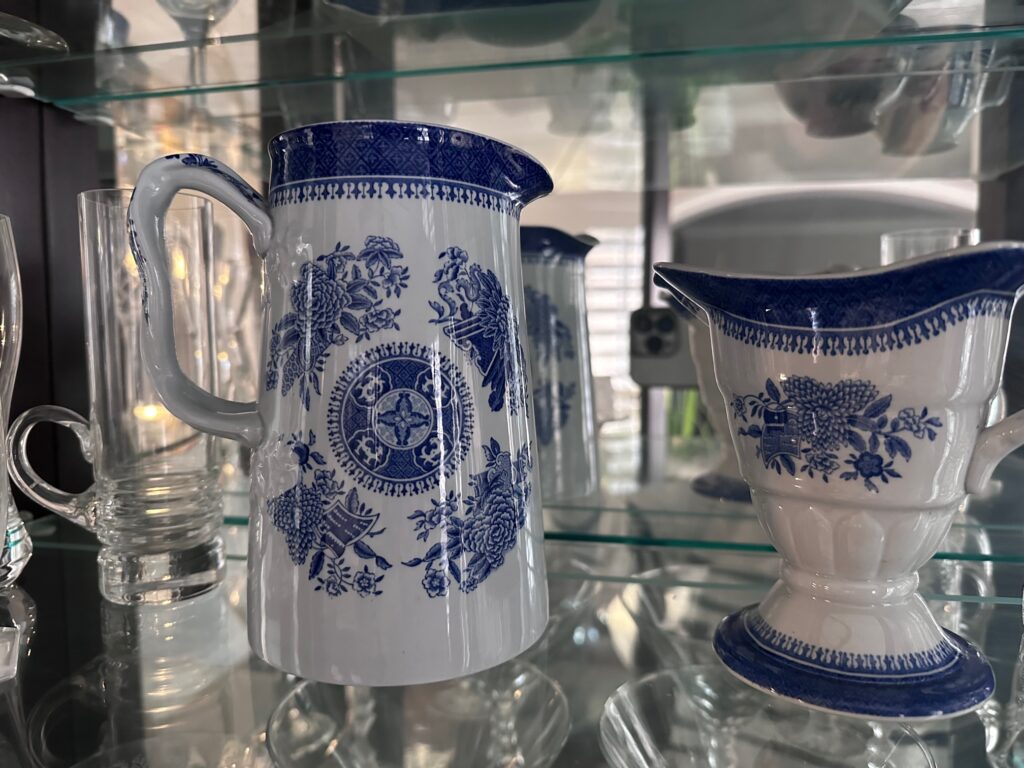
Fitzhugh Spode is now discontinued. You can find it used in four colors: red, green, blue, and plum. The china Aunt Sally Lou and I collected is the ordinary blue Fitzhugh Spode. The original exports from the 18th and 19th centuries are worth thousands of dollars, however, virtually all of the items for sale are the less valuable and more common 20th century items. I’ve seen examples of each of the colors of the new Spode at other Fitzhugh relatives’ homes. One Fitzhugh cousin has a large collection of the plum china items in his home in England — they are gorgeous and by far the rarest and prettiest of the colors.
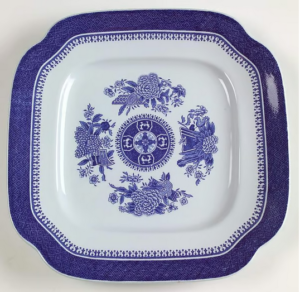
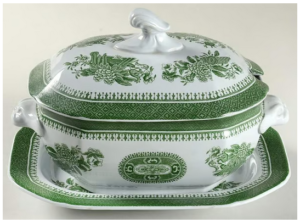
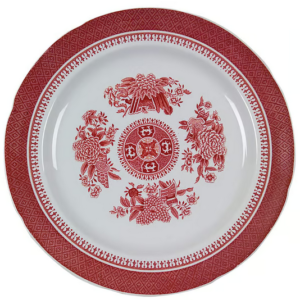

Is Fitzhugh Spode transferware?
Yes. Check out this image of a worker transferring the Spode Fitzhugh pattern to a plate from the Transferware Collectors Club:
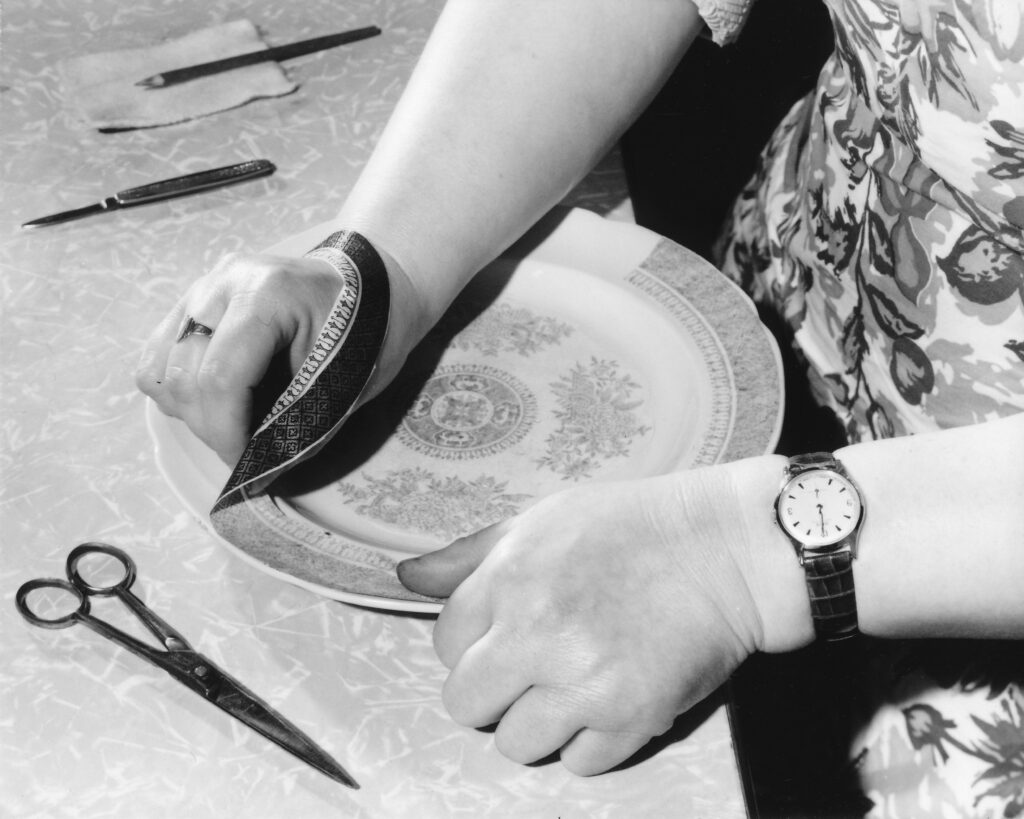
Collecting Fitzhugh export china
Original Fitzhugh exports are very expensive. Read this to avoid fakes:
If you are a beginning collector of Chinese export porcelain the name Fitzhugh can be confusing and important. While Fitzhugh is an English name, it is also the pattern name for some very expensive Chinese export porcelain. Among the patterns’ claim to fame is its rarity. It is one of the most expensive examples of porcelain exported from China (1775-1850.)
There are several theories as to how the name Fitzhugh became a pattern name for porcelain made in China. One legend is that it was ordered by an American sea captain by the name of Fitzhugh who liked the design. Another, that it was the mispronunciation of the Chinese city of Foochow. Finally, could it be called Fitzhugh since Thomas Fitzhugh was the president of the select committee of supercargos at Canton in the 1780s? And, that the family shipped vast quantities of Chinese porcelain to England.
CLUES-Basically the Fitzhugh pattern can be recognized by a diapered border and a central medallion, surrounded by four panel decorations. These represent Chinese symbols of the philosophy of life and the arts. While the designs are usually one color, the exception is the use of the American eagle and shield in red, white and blue as the central medallion. Borders were in the various colors used in the pattern. The most common is blue. Other colors are orange, green, sepia, yellow, black and gold.
Borders of stylized butterflies date from 1785 and are the rarest. Other motifs included pomegranates, Buddha’s hand and diaper forms.
Fitzhugh, like other Chinese Export patterns was never signed. So, if you are offered a piece having a square, pseudo Chinese mark, with a running “S” beside it, you’ve found a very collectible piece. Such pieces were made in France in the 19th century by Emile Samson, a famous copyist. These days it has collectors and a value all its own. The pattern was also adapted by Caughley and Coalport in England.
Before you get excited about what looks like a Fitzhugh plate you discovered on a dusty antiques shop shelf, remember, it has never stopped being reproduced.
During the 1976 American Bicentennial bowls decorated in the Fitzhugh pattern in green, orange and blue and American eagle medallions were popular repros. Somewhere along the way they lost their proper import stickers saying “made in Hong Kong.” One clue is the new Hong pieces are very white, compared to authentic pieces.
Separating the legend of Fitzhugh porcelain from fact, by Anne Gilbert Sep 24, 2018, Updated Sep 24, 2018 http://www.collectorsjournal.com/columns/separating-the-legend-of-fitzhugh-porcelain-from-fact/article_f1238f34-bfff-11e8-9408-7f5c19e53875.html
See also
FitzHugh pattern have been and are reproduced. Collectors should get to know the typical shapes. Because FitzHugh was popular in the late 18th and early 19th century the shapes of pieces should reflect the style of the period – larger dinner plates with a shallow curved rim, drum shaped teapots, helmet or hog snout pitchers, twisted stalk handles with elaborate leaf terminals. There should be no marks. The serving pieces are quite substantial and heavily potted, often with a noticeable “orange peel” surface. There should be noticeable wear – most prevalent on the fronts of plates where they were stacked together and on platters and dishes where food was scooped with spoons and meat was cut with steel bladed knives.
If there is gilt penciling over the enamel it should show some wear somewhere! Look for the typical small black spots and pin holes on the surface typical of Chinese export porcelain of the 18th and early 19th century, along with a slight grayish color to the paste itself. There are some obvious fakes around. Some orange and green enameled plates with very heavy and poorly painted decoration on very white sparkling porcelain. Sometimes these are bound in pewter rims. Be wary of green FitzHugh on which the design is done with decals and filled in with a very watery green enamel. Be especially wary of any eagle decorated green or orange FitzHugh – its coming out of China as we speak.
Gotherborg.org Chinese Export Porcelain for the West: Imperial Quality Export and the FitzHugh, ca. 1760-1810, The FitzHugh pattern 1780-1820, https://gotheborg.com/qa/exportforthewest.shtml

